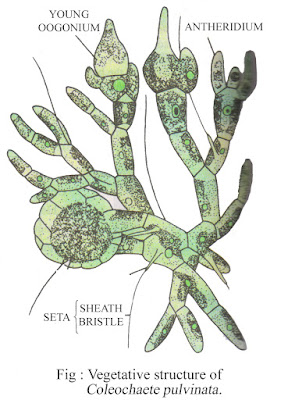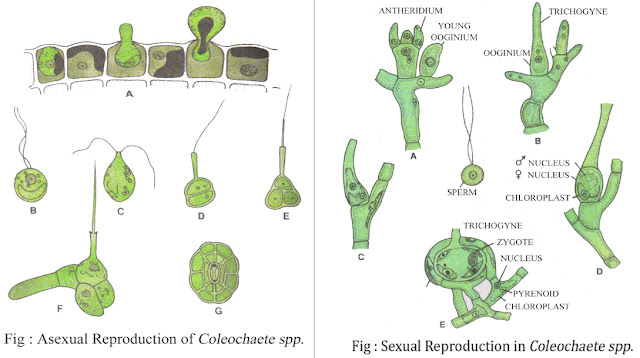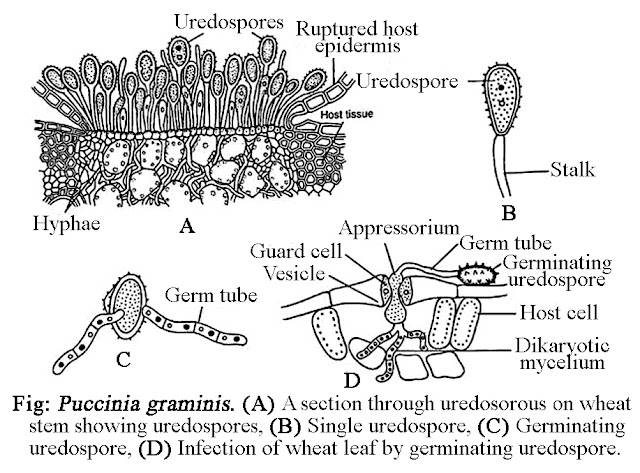COLEOCHAETE - STRUCTURE OF VEGETATIVE BODY AND REPRODUCTION
A. CLASSIFICATION:
Division – Chlorophyta
Class
– Chlorophyceae
Order
– Chaetophorales
Family
– Coleochataceae
Genus
– Coleochaete
The genus Coleochaete comprises about 10 species. It is a fresh water alga
which usually grows as an epiphyte upon other algae such as Vaucheria, Oedogonium, etc. Some of them
are also found to grow upon other submerged aquatic angiosperms such as Hydrilla, Potamogeton, Oedogonium, Lemma,
Thypa, Trapa, etc. Some species also grow endophytically with the cells of Chara and Nitella. The disc-like species (C.
scutata) grow on shells, glass and other substrates.
B. STRUCTURE OF THE VEGETATIVE BODY:
The structure of Coleochaete shows diverse forms. Some
species of Coleochaete have a very
much branched filamentous thallus which is distinctly heterotrichous in habit (C.
pulvinata). Other species grow as entirely prostrate in which the branches
radiating from a common centre and are laterally apposed to form a pseudoparenchymatous disc. However,
occasionally erect branches may arise from the prostrate system at short
intervals.
In C. irregularis the thallus is distinctly branched, prostrate
filaments. In the thalli of C. solute, C.
scutata and C. orbicularis, the
thalli are more regular and circular.
C. REPRODUCTION: Coleochaete reproduces both by asexual and sexual methods of
reproduction.
1. Asexual Reproduction:-
It takes place by means of motile asexual spores called zoospores. Zoospores are developed from the terminal or
sub-terminal vegetative cells of the thallus. Each zoospore is biflagellate,
ovoid or rounded structure. It possesses a single chloroplast and is without eye spot. On maturity the zoospores
escape through the opening formed at the apex of a short papilla-like
outgrowth.
After liberation each
zoospores takes a short period of rest and secretes a wall, restore flagella
and produce a one-celled germling. The germling soon begins to germinate. During
germination it divides transversely into two daughter cells. The upper one forms the seta and the lower one
divides and redivides, finally producing a discoid thallus.
In heterotrichous
form the germinating zoospore first produces a branched prostrate system from
which the branches of erect system arise later.
2. Sexual Reproduction:- Sexual reproduction
is of advanced oogamous type followed by the fruit formation. The plants may be
monoecious (C. pulvinata) or dioecious (C. scutata). The male sex
organs are called antheridia and the
female oogonia or carpogonia.
(a)
Oogonia:- The
female sex organs i.e., oogonia are formed terminally on the marginal cells of
the short lateral branch of the projecting filaments.
Each oogonium is a
cone shaped or flask shaped structure with a swollen basal portion and a long
neck-like extension called trichogyne.
Hence oogonia are called carpogonia.
The basal portion contains a single
nucleus and chloroplast with a pyrenoid. All these combined to form the
egg. At maturity the trichogyne
disintegrates.
(b)
Antheridia:- The
antheridia are usually borne terminally in groups on the branches of erect
system. The antheridia arise as colourless, bluntly conical outgrowths from the
terminal cells of the lateral branches. The protoplast of each antheridium
metamorphoses into a single colourless and biflagellate antherozoid or sperm.
(c) Fertilization:- The liberated antherodoids swim
towards the opened neck of the oogonium. On reaching the neck, they are
attached to the disintegrated trichogyne. Finally, one antherozoid enters the
oogonium and fuses with the egg to complete the fertilization. As a result a diploid zygote (2n) is formed.
After fertilization the zygote is
retained within the oogonium, secretes a thick wall and increases in size
greatly. Under favourable condition, the zygote nucleus (2n) divides
meiotically until 16 – 32 daughter nuclei are formed. Simultaneously, the wall
formation between the nuclei takes place, which results in the formation of
daughter cells.
Each daughter cell is
metamorphosed into a single biflagellate zoospore
or swarmer. All the swarmers are liberated by breaking of the zygote wall,
and after a little period of rest, it develops into a new individual.
*************





Comments
Post a Comment